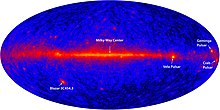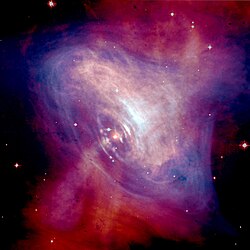Crab Pulsar
| Observation data Epoch J2000 Equinox J2000 | |
|---|---|
| Constellation | Taurus |
| Right ascension | 05h 34m 31.97s |
| Declination | +22° 00' 52.1" |
| Apparent magnitude (V) | 16.5 |
| Characteristics | |
| Evolutionary stage | Neutron star |
| U−B color index | −0.45 |
| B−V color index | +0.5 |
| Astrometry | |
| Proper motion (μ) | RA: −14.7±0.8[2] mas/yr Dec.: 2.0±0.8[2] mas/yr |
| Distance | 2000[2] pc |
| Details | |
| Radius | 10 km |
| Luminosity | 0.9 L☉ |
| Temperature | center (modeled): ~3×108[3] K, surface: ~1.6 × 106 K |
| Rotation | 33.5028583 ms[2] |
| Age | 967 years as observed from Earth. Due to Light delay, the actual age of the pulsar would likely be 7467±2567 years years |
| Other designations | |
| Database references | |
| SIMBAD | data |
The Crab Pulsar (PSR B0531+21) is a relatively young neutron star. The star is the central star in the Crab Nebula, a remnant of the supernova SN 1054, which was widely observed on Earth in the year 1054.[4][5][6] Discovered in 1968, the pulsar was the first to be connected with a supernova remnant.[7]

The Crab Pulsar is one of very few pulsars to be identified optically. The optical pulsar is roughly 20 kilometres (12 mi) in diameter and has a rotational period of about 33 milliseconds, that is, the pulsar "beams" perform about 30 revolutions per second.[3] The outflowing relativistic wind from the neutron star generates synchrotron emission, which produces the bulk of the emission from the nebula, seen from radio waves through to gamma rays. The most dynamic feature in the inner part of the nebula is the point where the pulsar's equatorial wind slams into the surrounding nebula, forming a termination shock. The shape and position of this feature shifts rapidly, with the equatorial wind appearing as a series of wisp-like features that steepen, brighten, then fade as they move away from the pulsar into the main body of the nebula. The period of the pulsar's rotation is increasing by 38 nanoseconds per day due to the large amounts of energy carried away in the pulsar wind.[8]
The Crab Nebula is often used as a calibration source in X-ray astronomy. It is very bright in X-rays, and the flux density and spectrum are known to be constant, with the exception of the pulsar itself. The pulsar provides a strong periodic signal that is used to check the timing of the X-ray detectors. In X-ray astronomy, "crab" and "millicrab" are sometimes used as units of flux density. A millicrab corresponds to a flux density of about 2.4×10−11 erg s−1 cm−2 (2.4×10−14 W/m2) in the 2–10 keV X-ray band, for a "crab-like" X-ray spectrum, which is roughly power-law in photon energy: I ~ E−1.1.[citation needed] Very few X-ray sources ever exceed one crab in brightness.
History of observation[]

The Crab Nebula was identified as the remnant of SN 1054 by 1939. Astronomers then searched for the nebula's central star. There were two candidates, referred to in the literature as the "north following" and "south preceding" stars. In September 1942, Walter Baade ruled out the "north following" star, but found the evidence inconclusive for the "south preceding" star.[9] Rudolf Minkowski, in the same issue of The Astrophysical Journal as Baade, advanced spectral arguments claiming that the "evidence admits, but does not prove, the conclusion that the south preceding star is the central star of the nebula".[10]
In late 1968, David H. Staelin and Edward C. Reifenstein III reported the discovery of two pulsating radio sources "near the crab nebula that could be coincident with it" using the 300-foot (91 m) Green Bank radio antenna.[11] They were given the designations NP 0527 and NP 0532. The period and location of the Crab Nebula pulsar NP 0532 was discovered by Richard V. E. Lovelace and collaborators on November 10, 1968, at the Arecibo radio observatory.[12]
A subsequent study by them, including William D. Brundage, also found that the NP 0532 source is located at the Crab Nebula.[13] A radio source was also reported coincident with the Crab Nebula in late 1968 by L. I. Matveenko in Soviet Astronomy.[14]
Optical pulsations were first reported by Cocke, Disney, and Taylor using the 36-inch (91 cm) telescope on Kitt Peak of the Steward Observatory of the University of Arizona.[15] Their discovery was confirmed by Nather, Warner, and Macfarlane.[16]
Jocelyn Bell Burnell, who co-discovered the first pulsar PSR B1919+21 in 1967, relates that in the late 1950s a woman viewed the Crab Nebula source at the University of Chicago's telescope, then open to the public, and noted that it appeared to be flashing. The astronomer she spoke to, Elliot Moore, disregarded the effect as scintillation, despite the woman's protestation that as a qualified pilot she understood scintillation and this was something else. Bell Burnell notes that the 30 Hz frequency of the Crab Nebula optical pulsar is difficult for many people to see.[17][18]
The Crab Pulsar was the first pulsar for which the spin-down limit was broken using several months of data of the LIGO observatory. Most pulsars do not rotate at constant rotation frequency, but can be observed to slow down at a very slow rate (3.7×10−10 Hz/s in case of the Crab). This spin-down can be explained as a loss of rotation energy due to various mechanisms. The spin-down limit is a theoretical upper limit of the amplitude of gravitational waves that a pulsar can emit, assuming that all the losses in energy are converted to gravitational waves. No gravitational waves observed at the expected amplitude and frequency (after correcting for the expected Doppler shift) proves that other mechanisms must be responsible for the loss in energy. The non-observation so far is not totally unexpected, since physical models of the rotational symmetry of pulsars puts a more realistic upper limit on the amplitude of gravitational waves several orders of magnitude below the spin-down limit. It is hoped that with the improvement of the sensitivity of gravitational wave instruments and the use of longer stretches of data, gravitational waves emitted by pulsars will be observed in future.[19] The only other pulsar for which the spin-down limit was broken so far is the Vela Pulsar.

In 2019 the Crab Nebula, and presumably therefore the Crab Pulsar, was observed to emit gamma rays in excess of 100 TeV, making it the first identified source of ultra-high-energy cosmic rays.[20]
References[]
| Wikimedia Commons has media related to Crab Pulsar. |
- ^ "Space Movie Reveals Shocking Secrets of the Crab Pulsar" (Press release). NASA. September 19, 2002.
- ^ Jump up to: a b c d ATNF Pulsar Catalogue database entry. See Manchester, R. N.; et al. (2005), "The Australia Telescope National Facility Pulsar Catalogue", Astronomical Journal, 129 (4): 1993–2006, arXiv:astro-ph/0412641, Bibcode:2005AJ....129.1993M, doi:10.1086/428488
- ^ Jump up to: a b Becker, W.; Aschenbach, B. (1995), "ROSAT HRI Observations of the Crab Pulsar An Improved Temperature Upper Limit for PSR 0531+21", in Alpar, M. A.; Kızıloğlu, Ü.; van Paradijs, J. (eds.), The Lives of the Neutron Stars, Proceedings of the NATO Advanced Study Institute on the Lives of the Neutron Stars, 450, Kluwer Academic, p. 47, arXiv:astro-ph/9503012, Bibcode:1995ASIC..450...47B, ISBN 978-0-7923-324-6-6
- ^ Supernova 1054 – Creation of the Crab Nebula.
- ^ Duyvendak, J. J. L. (1942), "Further Data Bearing on the Identification of the Crab Nebula with the Supernova of 1054 A.D. Part I. The Ancient Oriental Chronicles", Publications of the Astronomical Society of the Pacific, 54 (318): 91, Bibcode:1942PASP...54...91D, doi:10.1086/125409
Mayall, N. U.; Oort, Jan Hendrik (1942), "Further Data Bearing on the Identification of the Crab Nebula with the Supernova of 1054 A.D. Part II. The Astronomical Aspects", Publications of the Astronomical Society of the Pacific, 54 (318): 95, Bibcode:1942PASP...54...95M, doi:10.1086/125410 - ^ Brandt, K.; et al. (1983), "Ancient records and the Crab Nebula supernova", The Observatory, 103: 106, Bibcode:1983Obs...103..106B
- ^ Zeilik, Michael; Gregory, Stephen A. (1998), Introductory Astronomy & Astrophysics (4th ed.), Saunders College Publishing, p. 369, ISBN 978-0-03-006228-5
- ^ Supernovae, Neutron Stars & Pulsars.
- ^ Baade, Walter (1942), "The Crab Nebula", Astrophysical Journal, 96: 188, Bibcode:1942ApJ....96..188B, doi:10.1086/144446
- ^ Minkowski, Rudolf (1942), "The Crab Nebula", Astrophysical Journal, 96: 199, Bibcode:1942ApJ....96..199M, doi:10.1086/144447
- ^ Staelin, David H.; Reifenstein, III, Edward C. (1968), "Pulsating radio sources near the Crab Nebula", Science, 162 (3861): 1481–3, Bibcode:1968Sci...162.1481S, doi:10.1126/science.162.3861.1481, JSTOR 1725616, PMID 17739779, S2CID 38023534
- ^ IAU Circ. No. 2113, 1968.
- ^ Reifenstein, III, Edward C.; Staelin, David H.; Brundage, William D. (1969), "Crab Nebula Pulsar NPO527", Physical Review Letters, 22 (7): 311, Bibcode:1969PhRvL..22..311R, doi:10.1103/PhysRevLett.22.311
- ^ Matveenko, L. I. (1968), "Position of a Source of Small Angular Size in the Crab Nebula", Soviet Astronomy, 12: 552, Bibcode:1968SvA....12..552M
- ^ Cocke, W. J.; Disney, M.; Taylor, D. J. (1969), "Discovery of Optical Signals from Pulsar NP 0532", Nature, 221 (5180): 525, Bibcode:1969Natur.221..525C, doi:10.1038/221525a0, S2CID 4296580
- ^ Nather, R. E.; Warner, B.; Macfarlane, M. (1969), "Optical Pulsations in the Crab Nebula Pulsar", Nature, 221 (5180): 527, Bibcode:1969Natur.221..527N, doi:10.1038/221527a0, S2CID 4295264
- ^ Brumfiel (2007), "Air force had early warning of pulsars", Nature, 448 (7157): 974–975, Bibcode:2007Natur.448..974B, doi:10.1038/448974a, PMID 17728726
- ^ "Beautiful Minds: Jocelyn Bell Burnell", BBC television documentary broadcast 7 April 2010.
- ^ The LIGO Scientific Collaboration; Abbott, B.; Abbott, R.; Adhikari, R.; Ajith, P.; Allen, B.; Allen, G.; Amin, R.; Anderson, S. B.; Anderson, W. G.; Arain; Araya, M.; Armandula, H.; Armor, P.; Aso, Y.; Aston, S.; Aufmuth, P.; Aulbert, C.; Babak, S.; Ballmer, S.; Bantilan; Barish, B. C.; Barker, C.; Barker, D.; Barr, B.; Barriga, P.; Barton, M. A.; Bastarrika, M.; Bayer, K.; et al. (2008), "Beating the spin-down limit on gravitational wave emission from the Crab pulsar", Astrophys. J., 683 (1): L45–L50, arXiv:0805.4758, Bibcode:2008ApJ...683L..45A, doi:10.1086/591526
And erratum in Abbott, B.; et al. (2009), Astrophys. J., 706 (1): L203–L204, arXiv:0805.4758, Bibcode:2009ApJ...706L.203A, doi:10.1088/0004-637X/706/1/L203CS1 maint: untitled periodical (link) - ^ Amenomori, M. (13 June 2019). "First detection of photons with energy beyond 100 TeV from an astrophysical source". Phys. Rev. Lett. 123 (5): 051101. arXiv:1906.05521. Bibcode:2019PhRvL.123e1101A. doi:10.1103/PhysRevLett.123.051101. PMID 31491288. S2CID 189762075. Retrieved 8 July 2019.
- Crab Nebula
- Objects with variable star designations
- Optical pulsars
- Pulsars
- Taurus (constellation)
